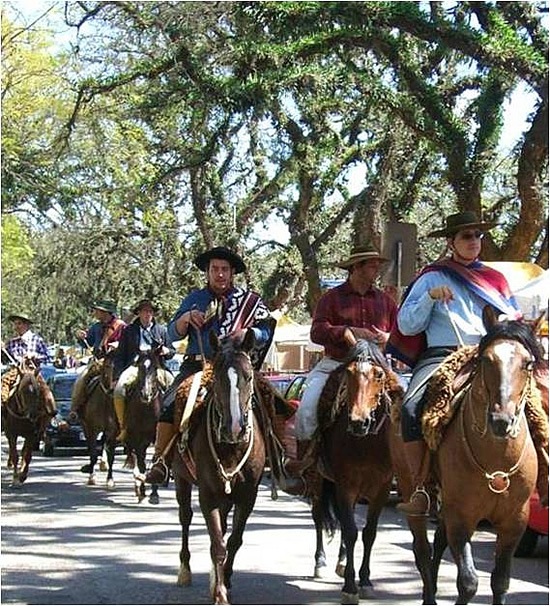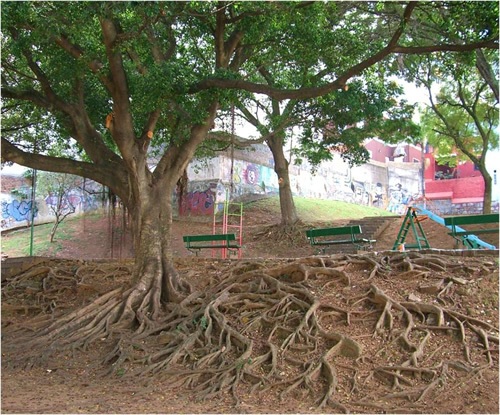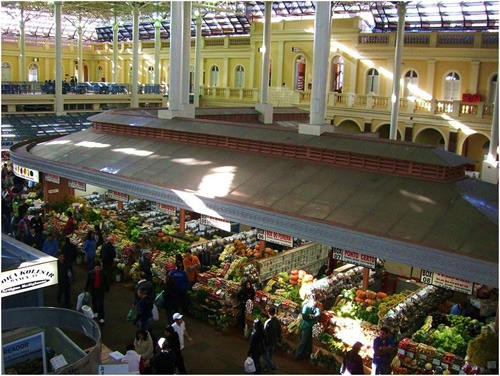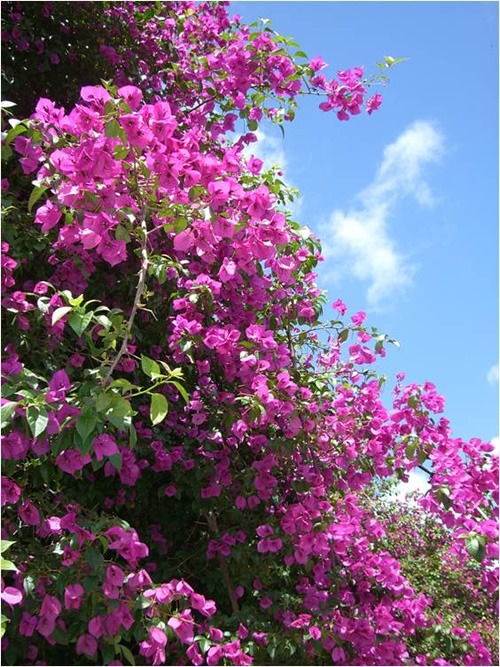|
An Exotic Way to Shake Up the Routine
From Cubicle to Colonial in Porto Alegre, Brazil
Article and photos by Jenny Miller

|
|
Gaucho Parade in Porto Alegre.
|
Nearly a year after moving, alone, to the southern Brazilian capital city of Porto Alegre, I find that I have started to take some of the refreshments (my word for all those seemingly-mundane details that attracted me to this place), for granted. So when I detected a tug of impatience while waiting for the bus yesterday, I reminded myself that the extra minutes were a gift. Courtesy of a new and hard-won lifestyle, spare moments bring a chance to admire the bizarre leaves and twisty branches on the trees, a pause to appreciate the pink and yellow hues that explode around me.

|
|
Roots of one of the many trees in Porto Alegre.
|
In many ways, I am a typical runaway. Fed up with harsh Chicago winters and my brain-deadening 9-to-5 secretarial job, I daydreamed of living in other lands and speaking in other languages. Travel juices up my creative side. Like any reputable junkie, over the last 10 years of taking overseas flights, I started feeling a need for the fixes in shorter intervals. The execution of my escape plan has been a little unconventional: I studied dutifully, lived frugally, Googled exhaustively, then crossed my fingers and hopped a 1-way flight to Brazil. The goal was to create the life I want to live — one which blends stimulation, imagination, adventure, and courage — and to write about it.
One reason I chose Porto Alegre over other cities was the green space. Purportedly there are 1.5 million trees here — about one for each inhabitant — and I theorize they are each unique. I once likened the vegetation to “Key West on Mars.” A more practical reason was the manageability of the city: it is big enough to necessitate an Arts & Entertainment section in Zero Hora, and small enough to feel a sense of community; there is ample public transportation for rainy days and pleasant pedestrian streets, riverfront paths, and park trails for sunny ones; and perhaps unlike São Paulo or Rio de Janeiro, being a foreigner here makes me more of a novelty than a target.
Porto Alegre feels Brazilian in some ways. The vibe is relaxed as people stroll casually in their havaianas, the lunches are long and always include arroz e feijão (black beans and rice), the samba and futebol are legendary and I share in the passionate appreciation of each. Yet there is a less predictable aura to the city. None of Brazil’s famed beaches are here. The regional cultural is strongly tied to its European roots: the German, Italian, Spanish, and Polish ancestries are revealed in the faces, surnames, and cuisine alike. This is also gaúcho country — the cowboys of the south — and even the city-dwellers take great pride in honoring the traditions of churrasco, chimarrão, and chivalry.
Two gems in the city that delighted me four years ago on a pre-expat reconnaissance mission are, today, staples in my routine. Casa de Cultura Mario Quintana typifies the charming cultural spaces scattered around town which offer art exhibits, foreign films, theater productions, and dance lessons for free (or next to nothing), thus providing accessible enrichment and entertainment to the masses. Mercado Público houses over one hundred stalls of meat, fish, dairy, and produce, as well as some of the city’s most acclaimed eateries. Sitting in the famed sorveteria, or ice cream parlor, in the heart of the market, one can soak in the habits and diversity of the population and admire the thriving entrepreneurial spirit of the city. Moreover, both locations are enchanting examples of the pastel-painted colonial architecture that makes Porto Alegre so pleasing to wander.

|
|
Mercado Publico in Porto Alegre.
|
My Brazilian days are diametrically opposed to my American ones, most strikingly because I have so much free time. When not advising an assortment of lawyers, accountants, and architects on Business English, or forcing myself to complete grammar drills in my arsenal of Portuguese textbooks, I indulge in pursuits of varying decadence. Occasionally I read the paper, comparing and contrasting the crime statistics to Chicago. Every now and then I drift off on a park bench, contemplating my values, like why I laugh when a soccer player fakes an injury but curse under my breath when a married man flirts brazenly on the street. In my new home, there is time to share perspectives and survival tips with my German and Kiwi girlfriends during the impromptu buffets we have dubbed International Ladies Lunch. I sip espresso habitually at Café à Brasileira, where I shelve study ambitions in favor of observing the rituals of the old men that consistently crowd the place.
Beyond schedule enhancements, I have gained much self-awareness and insight regarding the Brazilian way. Last week, sharing beers with friends, another American woman stated that — while she was enjoying her foray into Brazilian life — she and her Brazilian fiancé agreed to settle in the States. After years of studying and traveling abroad, she noted that she felt ready for the simplicity and predictability of her life there. She liked knowing the ins and outs of achieving bureaucratic tasks: she liked that her days didn’t frequently contain inconveniencing surprises. As she spoke I realized that one of the things I value most about life here is that every day I am forced to learn a new way of doing something. There is an apparent lack of organization in Brazil which is deceiving. Over time I have come to understand that, in reality, there is a wealth of structure here — it is just more elaborate and less obvious than I am used to. To illustrate, I went to several electronics shops searching for a replacement television remote before learning that they are purchased on the street. Specifically, I was directed to a man with a blanket spread out on Alberto Bins. (If it is shoelaces you are after, try Rua Senhor dos Passos.) One of my favorite Brazilian Portuguese words is jeitinho, which means “the little way” around an obstacle. Whether it takes the form of a political favor from a friend or a tip on finding a decent strapless bra, this society operates on jeitinhos. Though it requires a patient temperament, each time I discover another piece of insider information I feel a sense of achievement.
While it is easy to appreciate the embellishments my leap-of-faith has afforded, it is not always easy. Friendships have been forged effortlessly, but discovering common ground on which to build a relationship has proven difficult. Locals have reacted to my adventure with great delight, and though I am almost always made quite welcome, I am also always “The Foreigner.” Perks of the title include being the subject of gossip, regularly recognized by people I have never met, and occasionally being ripped off by taxi drivers who mistake my gringa accent for a lack of knowledge of the city’s layout.
Certainly, defining boundaries, improving cultural awareness and sensitivity, and widening the net of understanding with language acquisition are larger milestones along any traveler’s road. It is just as significant, however, to cherish little growth markers: to remember the first experiment with an unfamiliar snack or the first time a politically-charged local comic strip sparks laughter. It is key, for me, to keep in mind that I did not get to see the star-filled sky as I lay in bed in my former home for the bright lights of the city. I will take a moment tomorrow, and next week, to appreciate a bright, cheerful bloom that stops me in my path. Indeed the details of my plan were sketchy at best, but everything has fallen beautifully into place thus far.

|
|
Pink blooms in Porto Alegre.
|
|
For More Information
Expat Resources: www.gringoes.com hosts a discussion forum that is a great starting point if you’re considering a move to Brazil — covering everything from visas to banking to making friends.
What is churrasco? Southern Brazilian-style barbecue which is, essentially, lots of salty meat slow-cooked over an open flame. Though there are loads of churrascarias (restaurants) around, this meal is best enjoyed in the home of family or friends, and someone is usually hosting at least once a week.
What is chimarrão? A traditional tea prepared from yerba mate throughout southern Brazil, Uruguay, and Argentina (with slight regional variations). Served in a hollowed out gourd called a cuia and sipped through a silver straw called a bomba, the earthy-tasting tea is commonly served all day, every day.
Pre-arranging accommodations and work is nearly impossible in Brazil if you are not being sent here by a multinational corporation. It’s best to reconcile yourself to the fact that you’ll have to wing it — consider it an initiation to the ultra-relaxed Brazilian lifestyle. In Porto Alegre, the Sunday edition of the local paper is the best way to find an apartment, or you can look online for rentals. If you plan on teaching English, knocking on the doors of private language schools is the best bet.
The Foreigners in Porto Alegre group at Facebook.com has proven invaluable to my sanity as I acclimate to the country, providing a support network and information sharing between members of the expat community and locals alike.
|
Jenny Miller developed
a passion for travel backpacking around England in 1999. Subsequently
she studied, worked, and traveled around Europe. However, it
was a trip to Brazil in 2005 that changed her life path. Since
then, she devoted her energy toward planning her escape from
corporate life in Chicago. In 2008, she moved to Porto Alegre,
Brazil, where she is learning Portuguese.
|
